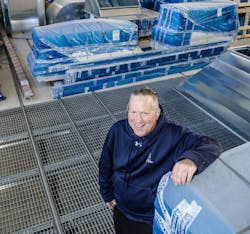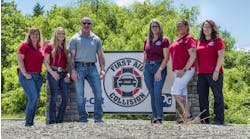The motor started to churn, and David Niestroy knew this was it—in this moment, he had successfully retrofitted his father’s lawnmower to power his very first paint booth.”
Not bad—especially for a 10-year-old. “Anyone can do anything if they put their minds to it,” Niestroy says. “That’s my firm belief.”
This small feat performed in his parents’ garage almost 40 years ago was just the first of many accomplishments to come in Niestroy’s career, which included founding 3D Auto Body & Collision Center in 1981 and eventually expanding it to seven locations in the Philadelphia area. That expansion is now culminating with his latest facility in Conshohocken, PA., which will host gas catalytic drying technology, considered by many to be the future of collision repair.
Growing his network of shops employing 86 people repairing 500 vehicles per month and generating $16 million in annual revenue across five locations has largely been based around his willingness to invest in new technology, he says. While for many business owners the investment robotic drying systems requires (it was close to $1 million for Niestroy) is too daunting, Niestroy almost sees it as a challenge.
“We constantly reinvest,” he says. “It’s only good for three to five years, and then something better comes out. We keep on moving with that technology.”
It’s that “build it and they will come” mentality that has fueled Niestroy from those early days in his parents’ garage to his current financial success. And while many of the process-oriented benefits are clear from 3D Auto Body’s KPIs (7.5-day cycle times and 5-hour touch times), he’s realizing one return on his investment he didn’t foresee—buy-in. From his team to insurance companies to customers, investing in technology isn’t just a mindset, it has become the business’s official brand: If you want the latest and greatest equipment and repair techniques used on your vehicle, come to 3D Auto Body.
3D Auto Body
—Location: 7 facilities near Philadelphia
Staff: 86
Average Monthly Car Count: 500
Annual Revenue: $16 million
*numbers do not include two newest facilities
The Investment
Back in 1981, when the very first 3D Auto Body location was in its early stages, Niestroy bought a fax machine for $1,200.
You might be thinking, “So what?”
But back then, when Niestroy says very few dealerships and vendors had fax machines, the response was more like, “Why would you buy that?”
“I thought, ‘What a great way to transfer information. Instead of saying a part number over the phone, this makes way more sense,’” Niestroy says.
From downdraft paint booths to plastic welding equipment to aluminum repair training to gas catalytic drying, remaining ahead of the curve wasn’t just some gimmick for Niestroy. It just … made sense. And it has separated 3D from the competition.
Budgeting for technological upgrades and the subsequent training required is a yearly focus for Niestroy and his management team, and it has slowly bled into every component of the business.
The Return: Teammates
Don’t even think about calling them “employees” or “staff members.”
“We don’t have employees—we have teammates and colleagues,” Niestroy says.
Niestroy has never been worried when opening a new location, including his new 30,000-square-foot, 26-bay facility equipped with robotic drying capabilities, for two reasons: First, he’s got a pool of candidates itching to work at 3D Auto Body; and second, he’s got a pool of teammates eager to transfer facilities and fill one of the shop’s open 20 technician positions.
And both reasons are fueled by one fact: They all want to use the latest and greatest equipment.
“You really cannot underestimate how much technicians want the newest stuff,” Niestroy says. “Technicians are some of the smartest people I’ve met, and they crave anything that will make them faster and better at their jobs.”
Having multiple facilities has presented Niestroy with a unique opportunity when it comes to investing in equipment. He will test new tools, such as plastic welders, at one facility, and if he sees a significant return on investment, he will begin to populate the equipment at other facilities. Expecting that established trend to continue, technicians at other shops are informed of improving numbers at the test facility and are primed for upgrades that will allow them to be more efficient.
Because everyone operates on a team-based flat-rate system and receives bonuses by meeting certain KPI benchmarks, technicians are committed to any equipment that can improve the process and increase the amount of work they can push through as a team—and if moving to the new gas catalytic drying facility will do that? Then you can bet employees are willing to make the move.
The Return: Insurance
“The idea is to make [the insurance companies] look great by giving them the numbers they want,” Camacho says. “That way, you’re going to end up with the lion’s share of the work.”
That’s been the mentality since day one, as Niestroy has always relied on his DRP relationships when providing a steady flow of work to new facilities when they open. By closely tracking his shops’ KPIs and how they improve as he invests in equipment upgrades, he’s always been able to market his shop as a standout in the Philadelphia area to insurance companies.
So once he considered how it could improve DRP relations, the new facility became a no-brainer for Niestroy.
“If I can fix these cars in days or hours as opposed to weeks, I don’t see how insurance companies can turn their heads on it. The better they look, the more they get paid.” he says. “I believe in the technology, and I believe in the way that it works so strongly that I’m willing to take that risk.”
The Return: Customers
If you visit 3D Auto Body’s website, before you can click on a link or even peruse the home page, a window pops up, providing two links to press releases detailing the shop’s sixth and seventh locations located in Drexel Hill and Conshohocken, Penn.
Armed with standout numbers (30,000 square feet; 26 bays; sixth location), 3-D renderings of the facility’s interior and exterior, and even a little bit of information about gas catalytic drying, these press releases embody Camacho’s approach as a marketer: Get in front of the public, flaunt your commitment to technology, and show why you’re better than everyone else.
And then, just … stop. Because that’s all you need to get them hooked.
“The first step is to make it public. Then, if they want to know more, you can worry about the arduous task taking them step by step through the technology,” he says. “You don’t want to show them how—you want to show them what it’s going to do for them. You want to market the shop itself and how it’s going to change the game for the customer.”
Moving Forward
While Niestroy certainly believes he could stop right where he’s at and undoubtedly stay technologically ahead of other shops in his area, that’s simply not his style.
That’s why, even after establishing his robotic gas drying facility, he and his management team will continue to look for new ways of innovating and expanding their position as a leader in the industry.
And part of being a leader involves ensuring the next wave of technicians: In addition to his own employees, Niestroy has cultivated a constant stream of job candidates by marketing his dedication to updating the company’s tools and equipment and by hosting mock interviews and job-shadowing sessions for area technical college and high school students.
“These kids have no idea what they can do in this industry until you show them,” Niestroy says. “They don’t know they can be making six figures. They don’t know the technical expertise required. If we’re dedicated to showing them the possibilities of this industry, they’ll want to be part of it.”




